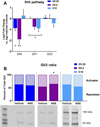Prenatal alcohol exposure disrupts Sonic hedgehog pathway and primary cilia genes in the mouse neural tube
- PMID: 34492310
- PMCID: PMC8529623
- DOI: 10.1016/j.reprotox.2021.09.002
Prenatal alcohol exposure disrupts Sonic hedgehog pathway and primary cilia genes in the mouse neural tube
Abstract
Neurulation-stage alcohol exposure (NAE; embryonic day [E] 8-10) is associated with midline craniofacial and CNS defects that likely arise from disruption of morphogen pathways, such as Sonic hedgehog (Shh). Notably, midline anomalies are also a hallmark of genetic ciliopathies such as Joubert syndrome. We tested whether NAE alters Shh pathway signaling and the number and function of primary cilia, organelles critical for Shh pathway transduction. Female C57BL/6 J mice were administered two doses of alcohol (2.9 g/kg/dose) or vehicle on E9. Embryos were collected 6, 12, or 24 h later, and changes to Shh, cell cycle genes, and primary cilia were measured in the rostroventral neural tube (RVNT). Within the first 24 h post-NAE, reductions in Shh pathway and cell cycle gene expression and the ratio of Gli3 forms in the full-length activator state were observed. RVNT volume and cell layer width were reduced at 12 h. In addition, altered expression of multiple cilia-related genes was observed at 6 h post-NAE. As a further test of cilia gene-ethanol interaction, mice heterozygous for Kif3a exhibited perturbed behavior during adolescence following NAE compared to vehicle-treated mice, and Kif3a heterozygosity exacerbated the hyperactive effects of NAE on exploratory activity. These data demonstrate that NAE downregulates the Shh pathway in a region of the neural tube that gives rise to alcohol-sensitive brain structures and identifies disruption of primary cilia function, or a "transient ciliopathy", as a possible cellular mechanism of prenatal alcohol pathogenesis.
Keywords: Cell cycle; Development; Fetal alcohol spectrum disorders; Kif3a; Neurulation.
Copyright © 2021 Elsevier Inc. All rights reserved.
Conflict of interest statement
Competing interests
The authors have no conflicts of interest to report.
Figures





Similar articles
-
Short-term transcriptomic changes in the mouse neural tube induced by an acute alcohol exposure.Alcohol. 2023 Feb;106:1-9. doi: 10.1016/j.alcohol.2022.09.001. Epub 2022 Oct 4. Alcohol. 2023. PMID: 36202274 Free PMC article.
-
Transcriptome-Wide Regulation of Key Developmental Pathways in the Mouse Neural Tube by Prenatal Alcohol Exposure.Alcohol Clin Exp Res. 2020 Aug;44(8):1540-1550. doi: 10.1111/acer.14389. Epub 2020 Jul 1. Alcohol Clin Exp Res. 2020. PMID: 32557641 Free PMC article.
-
Forward genetics uncovers Transmembrane protein 107 as a novel factor required for ciliogenesis and Sonic hedgehog signaling.Dev Biol. 2012 Aug 15;368(2):382-92. doi: 10.1016/j.ydbio.2012.06.008. Epub 2012 Jun 12. Dev Biol. 2012. PMID: 22698544 Free PMC article.
-
Primary cilia and graded Sonic Hedgehog signaling.Wiley Interdiscip Rev Dev Biol. 2012 Sep-Oct;1(5):753-72. doi: 10.1002/wdev.43. Epub 2012 Apr 4. Wiley Interdiscip Rev Dev Biol. 2012. PMID: 23799571 Review.
-
The relationship between sonic Hedgehog signaling, cilia, and neural tube defects.Birth Defects Res A Clin Mol Teratol. 2010 Aug;88(8):633-52. doi: 10.1002/bdra.20686. Birth Defects Res A Clin Mol Teratol. 2010. PMID: 20544799 Free PMC article. Review.
Cited by
-
The ameliorative effects of choline on ethanol-induced cell death in the neural tube of susceptible BXD strains of mice.Front Neurosci. 2023 Sep 18;17:1203597. doi: 10.3389/fnins.2023.1203597. eCollection 2023. Front Neurosci. 2023. PMID: 37790585 Free PMC article.
-
Gastrulation-stage alcohol exposure induces similar rates of craniofacial malformations in male and female C57BL/6J mice.Birth Defects Res. 2024 Jan;116(1):e2292. doi: 10.1002/bdr2.2292. Epub 2023 Dec 20. Birth Defects Res. 2024. PMID: 38116840 Free PMC article.
-
Nonconceptus Mechanisms of Prenatal Alcohol Exposure That Disrupt Embryo-Fetal Development: An Integrative View.Alcohol Res. 2025 Jul 16;45(1):07. doi: 10.35946/arcr.v45.1.07. eCollection 2025. Alcohol Res. 2025. PMID: 40692661 Free PMC article. Review.
-
Alcohol exposure suppresses ribosome biogenesis and causes nucleolar stress in cranial neural crest cells.PLoS One. 2024 Jun 28;19(6):e0304557. doi: 10.1371/journal.pone.0304557. eCollection 2024. PLoS One. 2024. PMID: 38941348 Free PMC article.
-
Gene-environment interactions in birth defect etiology: Challenges and opportunities.Curr Top Dev Biol. 2023;152:1-30. doi: 10.1016/bs.ctdb.2022.10.001. Epub 2022 Nov 14. Curr Top Dev Biol. 2023. PMID: 36707208 Free PMC article. Review.
References
-
- Cook CS, Nowotny AZ, Sulik KK, Fetal alcohol syndrome: eye malformations in a mouse model, Archives of Ophthalmology 105(11) (1987) 1576–1581. - PubMed
-
- Godin EA, O’Leary Moore SK, Khan AA, Parnell SE, Ament JJ, Dehart DB, Johnson BW, Allan Johnson G, Styner MA, Sulik KK, Magnetic Resonance Microscopy Defines Ethanol Induced Brain Abnormalities in Prenatal Mice: Effects of Acute Insult on Gestational Day 7, Alcoholism: Clinical and Experimental Research 34(1) (2010) 98–111. - PMC - PubMed
-
- Dunty WC, Chen S.y., Zucker RM, Dehart DB, Sulik KK, Selective Vulnerability of Embryonic Cell Populations to Ethanol Induced Apoptosis: Implications for Alcohol Related Birth Defects and Neurodevelopmental Disorder, Alcoholism: Clinical and Experimental Research 25(10) (2001) 1523–1535. - PubMed
Publication types
MeSH terms
Substances
Grants and funding
LinkOut - more resources
Full Text Sources
Research Materials

